Multiple myeloma epidemiology and demographics: Difference between revisions
(→Age) |
(→Race) |
||
| Line 30: | Line 30: | ||
===Race=== | ===Race=== | ||
*Multiple myeloma usually affects individuals of the African American and Native Pacific Islanders race. Asian and Native Indian individuals are less likely to develop multiple myeloma.<ref>Multiple myeloma. Wikipedia (2015)https://en.wikipedia.org/wiki/Multiple_myeloma#Pathophysiology Accessed on September, 20th 2015</ref> | *Multiple myeloma usually affects individuals of the African American and Native Pacific Islanders race. Asian and Native Indian individuals are less likely to develop multiple myeloma.<ref>Multiple myeloma. Wikipedia (2015)https://en.wikipedia.org/wiki/Multiple_myeloma#Pathophysiology Accessed on September, 20th 2015</ref> | ||
*Among African Americans, multiple myeloma is one of the top 10 leading causes of cancer deaths. <ref>Seer stat fact sheet. National cancer institute (2015)http://seer.cancer.gov/statfacts/html/mulmy.html Accessed on September, 20th 2015</ref> | *Among African Americans, multiple myeloma is one of the top 10 leading causes of cancer deaths.<ref>Seer stat fact sheet. National cancer institute (2015)http://seer.cancer.gov/statfacts/html/mulmy.html Accessed on September, 20th 2015</ref> | ||
==Gallery== | ==Gallery== | ||
Revision as of 12:18, 23 September 2015
|
Multiple myeloma Microchapters |
|
Diagnosis |
|---|
|
Treatment |
|
Case Studies |
|
Multiple myeloma epidemiology and demographics On the Web |
|
American Roentgen Ray Society Images of Multiple myeloma epidemiology and demographics |
|
Risk calculators and risk factors for Multiple myeloma epidemiology and demographics |
Editor-In-Chief: C. Michael Gibson, M.S., M.D. [1] Associate Editor(s)-in-Chief: Haytham Allaham, M.D. [2]
Overview
In 2012, the incidence of multiple myeloma was approximately 6.3 per 100,000 cases with a mortality rate of 3.3 per 100,000 cases in the United States.[1] The prevalence of multiple myeloma was estimated to be 89,658 cases in 2012 in the United States.[2][3] Multiple myeloma is the second most common blood cancer after non-Hodgkin's lymphoma & 14th most common cancer overall in United States.[4][5][6] Males are more commonly affected with multiple myeloma than females. The male to female ratio is approximately 1.54 to 1.[7][8] Multiple myeloma usually affects individuals of the African American and Native Pacific Islanders race. Asian individuals are less likely to develop multiple myeloma.[9] The incidence of multiple myeloma increases with age; the median age at diagnosis is between 65 to 70 years.[10]
Epidemiology and Demographics
Incidence
- In 2012, the incidence of multiple myeloma waws approximately 6.3 per 100,000 individuals with a case-fatality rate of 3.3 per 100,000 in the United States.[11]
- In 2014, multiple myeloma constituted approximately 1.4 percent of the estimated new cancer cases.[12]
- In 2015, the estimated incidence of multiple myeloma is 1.6% of all new cancer cases and 1.9% of all cancer mortality cases.[13]
- Multiple myeloma is the 14th leading cause of cancer death in the United States.[14]
- Since 1975, the overall multiple myeloma incidence has increased nearly 1 percent annually.[15]
Prevalance
- Myeloma is the 14th leading cause of cancer death in the United States.[16]
- Multiple myeloma is the second most prevalent blood cancer (10%) after non-Hodgkin's lymphoma.[4][17]
- There are approximately 76,000 people in the United States living with multiple myeloma. [18]
- Multiple myeloma represents approximately 1% of all cancers and 2% of all cancer deaths.[19]
- In 2012, there were an estimated 89,658 people living with multiple myeloma in the United States.[20]
Age
- The incidence of multiple myeloma increases with age where the median age at diagnosis is is 65 to 70 years. Recent statistics concerning earlier age of onset in multiple myelom indicate an increase in incidence among the population.[21]
- Multiple myeloma is a common malignancy of patients above 40 years old (70% of cases are diagnosed between 50 and 70 years of age.[22])
Gender
- Male are more commonly affected with multiple myeloma than female. The male to female ratio is approximately 1.54 to 1.[23]
Race
- Multiple myeloma usually affects individuals of the African American and Native Pacific Islanders race. Asian and Native Indian individuals are less likely to develop multiple myeloma.[24]
- Among African Americans, multiple myeloma is one of the top 10 leading causes of cancer deaths.[25]
Gallery

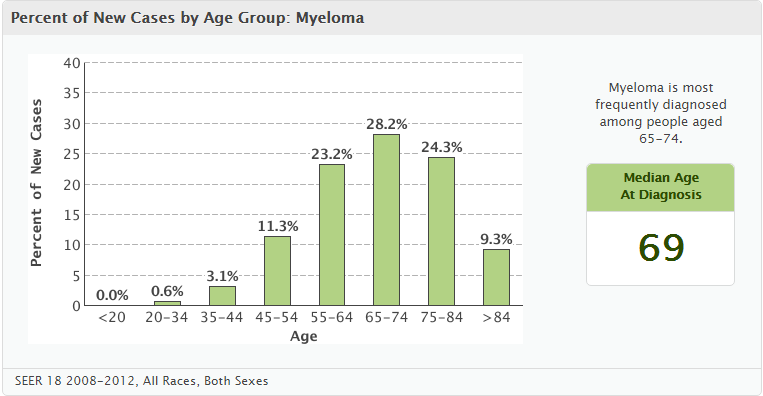
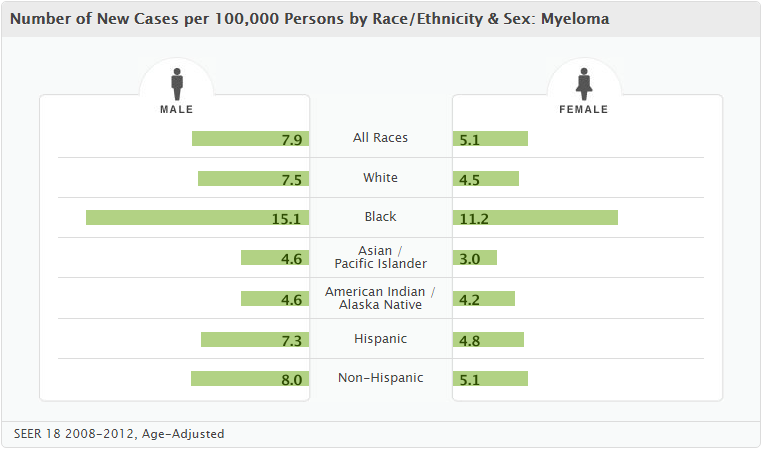
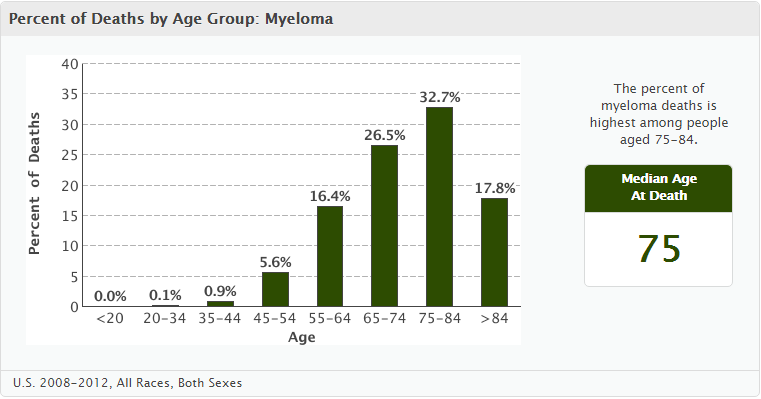
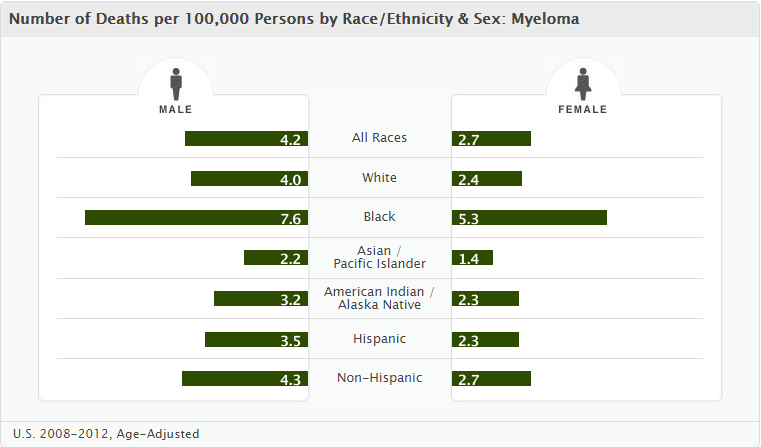
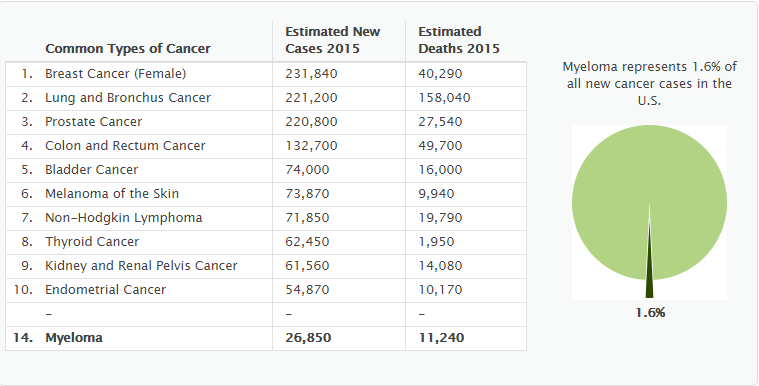

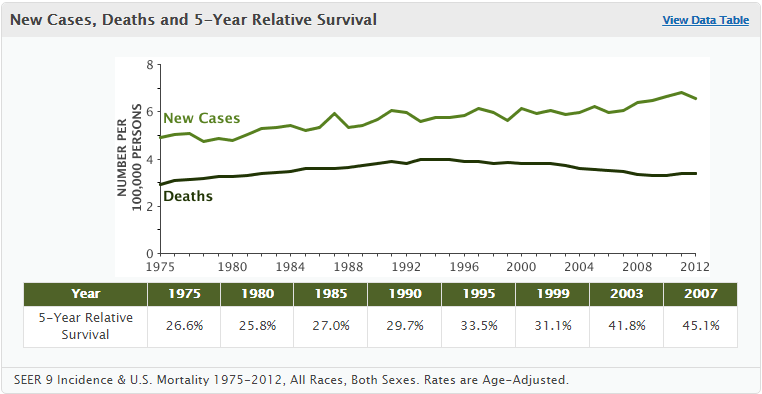
References
- ↑ Plasma cell neoplasm.National cancer institute (2015)http://www.cancer.gov/types/myeloma/hp/myeloma-treatment-pdq#cit/section_1.1
- ↑ Seer stat fact sheet. National cancer institute (2015)http://seer.cancer.gov/statfacts/html/mulmy.html Accessed on September, 20th 2015
- ↑ Multiple myeloma. Wikipedia (2015)https://en.wikipedia.org/wiki/Multiple_myeloma#Pathophysiology
- ↑ 4.0 4.1 Collins, CD. (2005). "Problems monitoring response in multiple myeloma". Cancer Imaging. 5 Spec No A: S119–26. doi:10.1102/1470-7330.2005.0033. PMID 16361127.
- ↑ Seer stat fact sheet. National cancer institute (2015)http://seer.cancer.gov/statfacts/html/mulmy.html Accessed on September, 20th 2015
- ↑ Multiple myeloma. Wikipedia (2015)https://en.wikipedia.org/wiki/Multiple_myeloma#Pathophysiology Accessed on September, 20th 2015
- ↑ Multiplemyeloma.Wikipedia(2015)https://en.wikipedia.org/wiki/Multiple_myeloma#Pathophysiology Accessed on September, 20th 2015
- ↑ Multiple myeloma. Radiopaedia (2015)http://radiopaedia.org/articles/multiple-myeloma-1 Accessed on September, 20th 2015
- ↑ Multiple myeloma. Wikipedia (2015)https://en.wikipedia.org/wiki/Multiple_myeloma#Pathophysiology Accessed on September, 20th 2015
- ↑ Multiple myeloma. Wikipedia (2015)https://en.wikipedia.org/wiki/Multiple_myeloma#Pathophysiology Accessed on September, 20th 2015
- ↑ Plasma cell neoplasm.National cancer institute (2015)http://www.cancer.gov/types/myeloma/hp/myeloma-treatment-pdq#cit/section_1.1
- ↑ A snapshot of myeloma. National cancer institute(2014)http://www.cancer.gov/research/progress/snapshots/myeloma Accessed on September, 20th 2015
- ↑ Seer stat fact sheet. National cancer institute (2015)http://seer.cancer.gov/statfacts/html/mulmy.html Accessed on September, 20th 2015
- ↑ Seer stat fact sheet. National cancer institute (2015)http://seer.cancer.gov/statfacts/html/mulmy.html Accessed on September, 20th 2015
- ↑ A snapshot of myeloma. National cancer institute(2014)http://www.cancer.gov/research/progress/snapshots/myeloma
- ↑ Seer stat fact sheet. National cancer institute (2015)http://seer.cancer.gov/statfacts/html/mulmy.html Accessed on September, 20th 2015
- ↑ Seer stat fact sheet. National cancer institute (2015)http://seer.cancer.gov/statfacts/html/mulmy.html Accessed on September, 20th 2015
- ↑ Seer stat fact sheet. National cancer institute (2015)http://seer.cancer.gov/statfacts/html/mulmy.html Accessed on September, 20th 2015
- ↑ Multiple myeloma. Wikipedia (2015) https://en.wikipedia.org/wiki/Multiple_myeloma. Accessed on September, 20th 2015
- ↑ Seer stat fact sheet. National cancer institute (2015)http://seer.cancer.gov/statfacts/html/mulmy.html Accessed on September, 20th 2015
- ↑ Press Releases. Compugen (2015)http://www.cgen.com/media-center/press-releases/-314 Accessed on September, 20th 2015
- ↑ Multiple myeloma. Radiopaedia (2015)http://radiopaedia.org/articles/multiple-myeloma-1 Accessed on September, 20th 2015
- ↑ Multiple myeloma. Radiopaedia (2015)http://radiopaedia.org/articles/multiple-myeloma-1 Accessed on September, 20th 2015
- ↑ Multiple myeloma. Wikipedia (2015)https://en.wikipedia.org/wiki/Multiple_myeloma#Pathophysiology Accessed on September, 20th 2015
- ↑ Seer stat fact sheet. National cancer institute (2015)http://seer.cancer.gov/statfacts/html/mulmy.html Accessed on September, 20th 2015
- ↑ SEER Stat Fact Sheets: Myeloma. Surveillance, Epidemiology, and End Results Program Turning Cancer Data Into Discovery.http://seer.cancer.gov/statfacts/html/mulmy.html Accessed on September ,20 2015
- ↑ SEER Stat Fact Sheets: Myeloma. Surveillance, Epidemiology, and End Results Program Turning Cancer Data Into Discovery.http://seer.cancer.gov/statfacts/html/mulmy.html Accessed on September ,20 2015
- ↑ SEER Stat Fact Sheets: Myeloma. Surveillance, Epidemiology, and End Results Program Turning Cancer Data Into Discovery.http://seer.cancer.gov/statfacts/html/mulmy.html Accessed on September ,20 2015
- ↑ SEER Stat Fact Sheets: Myeloma. Surveillance, Epidemiology, and End Results Program Turning Cancer Data Into Discovery.http://seer.cancer.gov/statfacts/html/mulmy.html Accessed on September ,20 2015
- ↑ SEER Stat Fact Sheets: Myeloma. Surveillance, Epidemiology, and End Results Program Turning Cancer Data Into Discovery.http://seer.cancer.gov/statfacts/html/mulmy.html Accessed on September ,20 2015
- ↑ SEER Stat Fact Sheets: Myeloma. Surveillance, Epidemiology, and End Results Program Turning Cancer Data Into Discovery.http://seer.cancer.gov/statfacts/html/mulmy.html Accessed on September ,20 2015
- ↑ SEER Stat Fact Sheets: Myeloma. Surveillance, Epidemiology, and End Results Program Turning Cancer Data Into Discovery.http://seer.cancer.gov/statfacts/html/mulmy.html Accessed on September ,20 2015
- ↑ SEER Stat Fact Sheets: Myeloma. Surveillance, Epidemiology, and End Results Program Turning Cancer Data Into Discovery.http://seer.cancer.gov/statfacts/html/mulmy.html Accessed on September ,20 2015